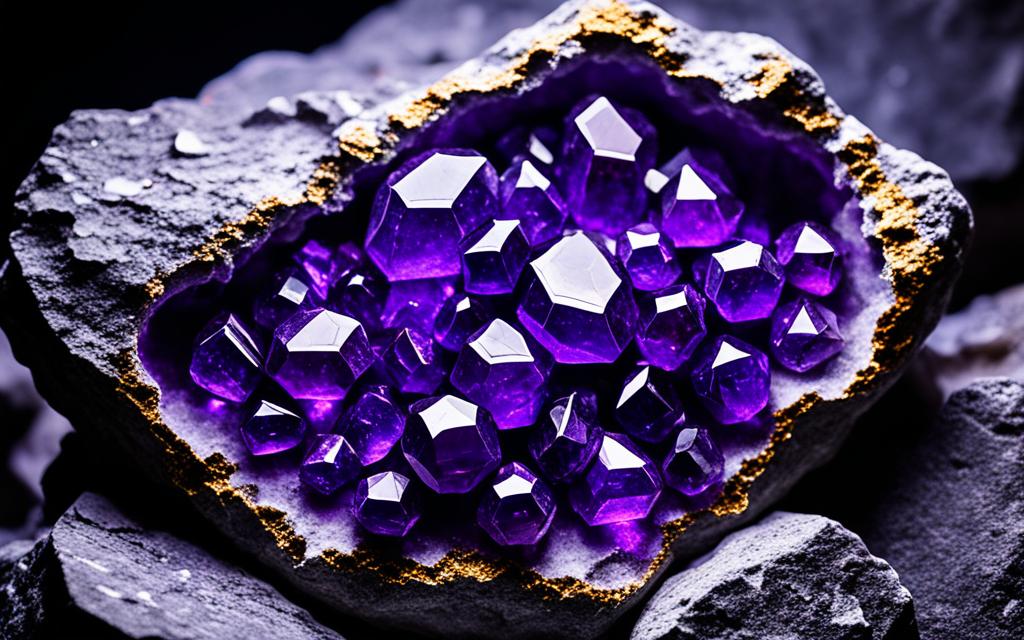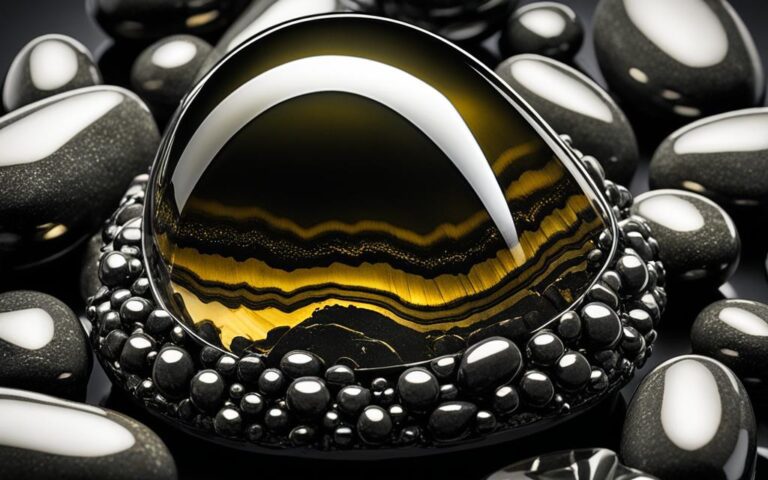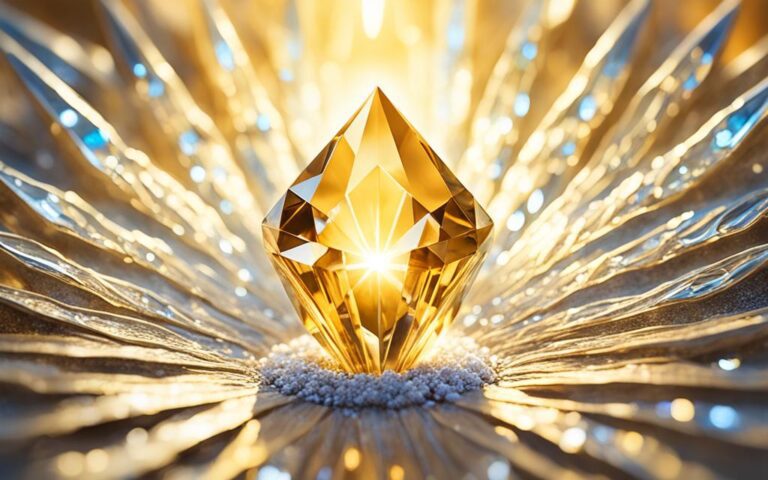Turkish Amethyst: Exploring Turkey’s Purple Gem
Did you know Turkey is home to a special type of amethyst? It’s called Turkish Amethyst or Alacam Amethyst. This gemstone is found in a single place in the Dursunbey District of Balikesir Province, near Ankara, Turkey. Its colors go from light lavender to deep purple, making it a favorite among gem lovers and jewelry makers.
Key Takeaways
- Turkish Amethyst, also known as Alacam Amethyst, is a unique variety of amethyst found exclusively in Turkey.
- The deposit was discovered in 2021 in the Dursunbey District of Balikesir Province, west of Ankara.
- Turkish Amethyst ranges in color from light lavender to deep, rich purple, with a variety of color accents.
- This semi-precious stone is prized for its beauty and potential historical significance in Turkey.
- Turkish Amethyst is suitable for a wide range of jewelry and ornamental uses, including necklaces, pendants, and carved pieces.
Introduction to Turkish Amethyst
Turkish Amethyst, also known as Alacam Amethyst, is a stunning type of purple quartz gemstone from Turkey. It’s famous for its beautiful colors, from light lavender to deep purple. The name “Amethyst” comes from the Greek word “amethystos,” meaning “not intoxicated.” This was because people thought it could stop you from getting drunk.
Definition and Description
Amethyst is a type of quartz, a common mineral on Earth. Turkish Amethyst is a special kind found in Turkey. These gemstones are loved for their clearness and bright purple colors. They are different from other Amethysts because of this.
Origin of the Name
The name “Amethyst” has an interesting story from ancient Greece. The word “amethystos” means “not intoxicated.” People thought wearing Amethyst could keep you sober. This legend and the gem’s lovely color have made it a symbol of value and beauty through the ages.
“Amethyst is a gem of great beauty and rarity, and the source of its name is as intriguing as the stone itself.”
Historical Background of Turkish Amethyst
The allure of Turkish Amethyst goes way back to ancient times. This gemstone was a big deal in the cultures and spiritual beliefs of many civilizations. From the early Neolithic period to the Roman Empire’s peak, its beautiful colors and supposed spiritual powers made it very popular.
People first started using Amethyst around 25,000 B.C. in Europe. The ancient Greeks saw it as a stone of protection. They thought it could keep them safe from Dionysus, the god of wine and getting drunk.
In the Roman Empire, Amethyst became even more valuable. Rich people and leaders wore it as jewelry and used it in decorations. The name “Amethyst” comes from the Greek word “amethystos,” meaning “not intoxicated.” This shows they thought it could stop people from getting drunk.
For centuries, Amethyst has kept its charm and importance in many cultures. The Ottoman Empire, which ruled parts of today’s Turkey, really valued Amethyst for its beauty and spiritual meaning. This made the gemstone a big part of Turkey’s cultural heritage.
Today, Turkey is still a big producer of Amethyst. The country’s mines give us some of the best and most wanted Amethyst in the world. Turkish Amethyst’s history and ongoing importance make it a gem that still fascinates and inspires people everywhere.
Physical Characteristics of Turkish Amethyst
Turkish Amethyst is a gemstone found in Turkey’s Anatolian region. It has a vibrant appearance and an intricate crystal structure. These features make it a highly valued treasure.
Appearance and Color Variations
Turkish Amethyst’s colors vary from light lilac to deep purple. Some have a unique purple-tinged grey-brown color. The crystals are prismatic and have a high luster that catches the light beautifully.
The Alacam Amethyst deposit in Turkey is famous for its wide range of colors. You can find amethyst, citrine, and smoky quartz there.
Crystal Structure and Formation
The crystal structure of Turkish Amethyst comes from hydrothermal activity and slow cooling in the earth. Mineral-rich solutions heat up and cool down, forming amethyst crystals. This process shows nature’s artistic side.
The unique conditions in Anatolia create these beautiful gemstones. Each one shows the power and beauty of nature.
“Turkish Amethyst is a true marvel of nature, showcasing the incredible diversity and complexity of the earth’s geological history.”
Common Locations and Mining Areas
Turkey is full of natural wonders, and amethyst is one of its treasures. The main source of Turkish Amethyst is the Alacam Amethyst mine in the Dursunbey District of Balikesir Province. This mine was found in 2021, offering a new source of the beautiful purple gemstone.
The Alacam Amethyst mine is a key spot, but Turkey has many other places with amethyst. Some other important places for Turkish Amethyst are:
- Kassiteres–Sapes
- Kirki
- Kornofolia
- Lesvos Island
- Milos Island
These spots in northern Greece are well-studied. They show the different types of rocks that create high-quality amethyst crystals. The amethyst from Turkey is known for its bright color, clearness, and unique traits.
Amethyst is a type of quartz found in many types of rocks. It can be in igneous, metamorphic, and sedimentary rocks. It also appears in hydrothermal veins, metasomatic deposits, and hot springs. The Turkish Amethyst is often linked to the tectonic rise of mountains. It forms in certain types of cracks in metamorphic rocks.
The demand for rare gemstones is rising worldwide. The discovery of the Alacam Amethyst mine and the search for more Turkish Amethyst spots make Turkey important in gemstone production. These purple gems are not just beautiful. They also show Turkey’s geological history and its rich variety.
Different Types of Turkish Amethyst
The Alacam Amethyst deposit in Turkey is famous for more than just the classic purple amethyst. It also produces citrine and smoky quartz, each with its own unique color. These colors come from different impurities mixing with the crystal structure.
Citrine, also known as “yellow quartz,” is highly desired for its golden color. This happens when heat changes the amethyst’s purple to a warm yellow. Smoky quartz, with its grey-brown color, gets its look from aluminum in the crystal.
These Turkish Amethyst types bring beauty and special properties to collections. Citrine is said to boost creativity and positivity. Smoky quartz is known for its grounding and protective qualities. Each type of Turkish Amethyst has its own special charm for collectors.
| Amethyst Type | Color | Formation |
|---|---|---|
| Classic Amethyst | Purple | Iron impurities in quartz |
| Citrine | Yellow | Exposure to heat transforms amethyst |
| Smoky Quartz | Grey-Brown | Aluminum impurities in quartz |
Turkish Amethyst comes in many types, each with its own beauty. From the rich purple to the golden citrine and the earthy smoky quartz, each gem has its own charm. They attract collectors and enthusiasts for their unique qualities.
Scientific Properties of Turkish Amethyst
Chemical Composition
Turkish Amethyst is a type of quartz with the chemical formula SiO2 (silicon dioxide). Its purple color comes from iron impurities in the crystal. These iron ions replace some silicon atoms, giving it its unique color.
Mohs Hardness Scale Rating
Amethyst scores a 7 on the Mohs Hardness Scale. This scale goes from 1 (softest) to 10 (hardest) and shows how well a mineral resists scratching. A rating of 7 means amethyst is quite tough and can handle daily wear well.
The special features of Turkish Amethyst make it very popular. Its Turkish Amethyst composition and Turkish Amethyst hardness make it a gemstone that lasts. Its Amethyst chemical formula and Amethyst Mohs scale rating show it’s a valuable gem from Turkey.
“Amethyst is a quartz of magmatic origin that has been known for thousands of years, and it was used to make jewelry in ancient Egypt, where it was known as the ‘gem of fire,’ with a market value equal to that of a diamond.”
Crystal System and Habit
Turkish Amethyst belongs to the hexagonal crystal system. This means it forms as prismatic crystals with a six-sided shape. The crystals have pointed ends and are made of silica (SiO2) with iron impurities that give them their purple color.
The Turkish Amethyst crystal habit is known for its sharp, hexagonal prisms. These crystals can be small or large, with the big ones showing a deep purple color. The Turkish Amethyst crystal system helps create these beautiful, pointed crystals. This makes them popular with collectors and jewelry lovers.
Turkish Amethyst can also form as drusy coatings on other minerals or rocks. These drusy amethysts show off the gem’s natural shine and beauty. They add a unique look to jewelry and decorations.
“Amethyst is a semi-precious yet popular gemstone that is abundant in nature, making it more affordably priced.”
The unique crystal system and shape of Turkish Amethyst make it popular for jewelry and spiritual uses. Knowing how it forms helps us see the beauty and value of this gemstone.
Optical Properties of Turkish Amethyst
Turkish Amethyst is a special type of quartz known for its amazing optical properties. It’s famous for its strong pleochroism. This means the color changes when you look at it from different angles. This makes the stone look even more vibrant and deep.
This gemstone also has high refractive indices. This makes it sparkle and shine brightly. The way it refracts light adds to its beauty, making it a true visual treat.
The Amethyst optics are key to its beauty and value. Its ability to show pleochroism and high refractive indices makes it popular for jewelry and spiritual items. People love its unique look.
The Amethyst refractive index is important for its shine and appeal. These special optical traits make Turkish Amethyst a favorite among gemstone lovers. It’s a natural wonder that captures the heart.
“The optical properties of Turkish Amethyst are truly mesmerizing, with its ability to display vibrant color shifts and captivating brilliance. This gemstone’s unique visual qualities make it a treasured and highly sought-after natural wonder.”
Metaphysical and Healing Properties
Turkish Amethyst is a powerful crystal with a long history. It’s known for its spiritual significance and healing properties. This purple quartz is linked to purification, peace, and change.
Spiritual Significance and Symbolism
Amethyst has been highly valued for its Amethyst spiritual significance. It helps ease anxiety, brings calm, and changes negative thoughts. Linked to the crown chakra, it aids spiritual growth and connection.
Healing Properties and Benefits
- Amethyst offers Amethyst healing benefits that balance the left and right brain sides.
- It’s said to help with sleep issues, bad dreams, and getting restful sleep.
- The stone enhances negotiation skills, decision-making, and public speaking.
- Amethyst supports wealth, business success, and handling responsibility and change.
The Turkish Amethyst metaphysical properties make it a top choice for crystal healing. Its ability to transform and heal has made it popular in crystal healing and metaphysical practices.
Emotional Properties of Turkish Amethyst
Turkish Amethyst is a beautiful purple gem known for its calming effects. It helps people find emotional balance and peace. This crystal is great for reducing stress and improving well-being.
One key benefit of Turkish Amethyst is its calming effect. Its purple color soothes the mind and body. It helps ease stress and anxiety, making life easier to handle.
This gemstone also boosts improved emotional intelligence. It helps with intuition and understanding emotions. This leads to better decision-making, stronger relationships, and personal growth.
- Calms the mind and body, reducing stress and anxiety
- Enhances emotional intelligence and self-awareness
- Promotes a sense of inner peace and emotional balance
- Facilitates personal growth and self-discovery
“Amethyst’s soothing energy can help calm the mind, easing anxiety and promoting a sense of inner peace.”
Turkish Amethyst is a powerful tool for emotional well-being and resilience. It helps with calming and self-awareness. This gemstone supports emotional healing and personal growth.
Meaning and Energy of Turkish Amethyst
Turkish Amethyst is a gemstone full of deep meaning and energy. It’s a type of purple quartz known for its calming and protective powers. This gemstone helps with spiritual growth and personal change.
The Amethyst energy is powerful and offers many benefits. It keeps the mind clear and the body strong. It also connects us to higher states of awareness, helping us tap into our intuition. Using Turkish Amethyst can help us grow personally, making life’s challenges easier to handle.
When we talk about Amethyst symbolism, we think of peace, balance, and wisdom. The Turkish Amethyst meaning is about helping us emotionally and spiritually. It guides us to understand ourselves and the world better.
Wearing Turkish Amethyst or using it in meditation can open up new consciousness. It helps us discover ourselves deeply. Its special energy is great for personal growth and spiritual awakening.
The meaning and energy of Turkish Amethyst make it popular in crystal healing and spiritual practices. It helps improve intuition and bring inner peace. Its complex nature encourages us to dive deep into our spiritual paths. This leads to more harmony and well-being in our lives.
Higher Frequencies of Turkish Amethyst
Turkish Amethyst is known for connecting people with higher energies. It helps raise one’s intuition and supports spiritual growth. It also helps release stress, making it easier to make wise choices and connect with inner wisdom.
This gemstone is great for those wanting to boost their Amethyst intuitive properties and Amethyst spiritual frequencies. It clears mental blocks, boosts psychic abilities, and brings calm and clarity. This makes it a key tool for meditation and personal change.
Turkish Amethyst has Turkish Amethyst high frequencies that connect with higher realms. This connection helps understand one’s purpose, increases self-awareness, and leads to a more balanced life.
“Amethyst is a stone of spirituality, contentment, and sobriety, excellent for meditation and cleansing energy fields.”
Using Turkish Amethyst can start a journey of personal growth. It helps unlock one’s potential and align with the universe’s higher vibrations.
| Location | Amethyst Characteristics |
|---|---|
| Turkey | Larger crystal clusters with tiny crystal terminations, creating a sparkly appearance |
| Thunder Bay, Canada | Gorgeous crystals often containing mineral inclusions like hematite and goethite |
| Various Locations | Wide range of hues, from light blue-ish to deep dark purples, with some appearing pink due to hematite inclusions |
Jewelry and Ornamental Uses
Turkish Amethyst is known for its deep purple color and shine. It’s been a favorite for jewelry and decorative pieces for a long time. Its beauty and special qualities make it a top choice for many uses.
It’s a hit in fine jewelry, from rings and pendants to earrings and bracelets. Its hardness means it can handle daily wear well. The gemstone comes in various purple shades that look great with gold, silver, or platinum.
| Amethyst Jewelry Types | Amethyst’s Characteristics |
|---|---|
|
|
Turkish Amethyst is also used in decorative items. You can find it in sculptures, vases, bookends, and paperweights. It adds luxury and style to any room. Its light-refracting abilities make it perfect for chandeliers and lamps.
Whether it’s worn or placed in the home, Turkish Amethyst is a gem. Its versatility and timeless beauty make it a favorite in luxury and design.
Caring for Turkish Amethyst
Looking after Turkish amethyst is key to keeping its beauty and power. Here are some tips to keep your gemstone looking great:
- Gentle Cleaning: Soak your amethyst jewelry in a mild solution of warm water and a few drops of dish soap for 15-20 minutes. Gently scrub with a soft-bristled toothbrush, then rinse thoroughly and air-dry with a clean cloth.
- Avoid Harsh Chemicals: Stay away from harsh cleaners, bleach, or abrasives. They can harm the amethyst’s crystal structure.
- Protect from Heat and UV: Too much heat or ultraviolet light can make the amethyst lose its color. Keep your jewelry out of direct sunlight and high-temperature places.
- Regular Maintenance: Clean your amethyst jewelry every few weeks to keep it shiny. If it gets chipped or cracked, see a professional jeweler.
By following these easy steps, you can keep your Turkish amethyst looking stunning and powerful for many years.
“Amethyst is a stone of peace, providing clarity and balance to the mind and emotions.”
With the right Turkish Amethyst care, Amethyst maintenance, and Amethyst cleaning, you can fully enjoy this amazing gemstone’s benefits in your life.
Conclusion
Turkish Amethyst is a special type of purple quartz from Turkey. It’s known for its unique color, spiritual meaning, and many uses. This gemstone captures the hearts of those who love nature’s beauty and power.
We’ve looked into its history, physical traits, scientific facts, and spiritual meanings. This deep dive shows why Turkish Amethyst is so valuable and popular. It tells the story of its origins, cultural importance, and symbolic value.
As we end our exploration, it’s clear Turkish Amethyst is more than just a pretty stone. It’s a symbol of Turkey’s rich natural and cultural history. It’s used in jewelry, spiritual practices, and admired for its beauty. This summary shows the lasting charm and importance of this purple gem.






